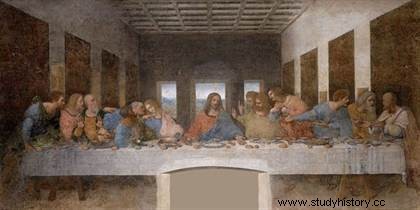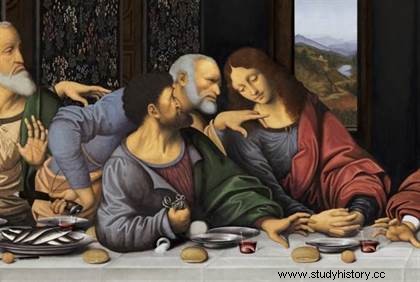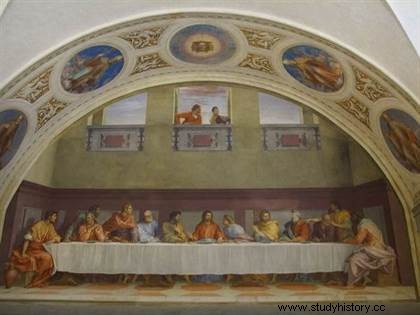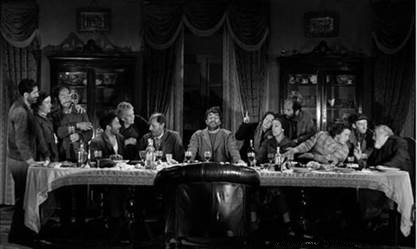 The Last Supper , frescoed by Leonardo da Vinci between 1494 and 1498 on the wall of the refectory of the Dominican convent of Santa Maria delle Grazie in Milan, is one of the most famous works of Christian art. It has the originality of illustrating a moment rarely represented in this episode of the Gospels:the reaction of the apostles to the announcement made by Jesus of the approaching betrayal of one of them. To achieve this composition, Leonardo da Vinci developed an unprecedented technique which quickly revealed itself to be extremely fragile. The degradation of the painting has required many renovations throughout history, which however have never managed to restore the original beauty of the Last Supper in the long term.
The Last Supper , frescoed by Leonardo da Vinci between 1494 and 1498 on the wall of the refectory of the Dominican convent of Santa Maria delle Grazie in Milan, is one of the most famous works of Christian art. It has the originality of illustrating a moment rarely represented in this episode of the Gospels:the reaction of the apostles to the announcement made by Jesus of the approaching betrayal of one of them. To achieve this composition, Leonardo da Vinci developed an unprecedented technique which quickly revealed itself to be extremely fragile. The degradation of the painting has required many renovations throughout history, which however have never managed to restore the original beauty of the Last Supper in the long term.
The Last Supper by Leonardo da Vinci, a revolutionary work
Commissioned to Leonardo da Vinc by the famous Duke of Milan Ludovico Sforza, the Last Supper is painted on a wall of the convent of Santa Maria delle Grazie in Milan. By the expressiveness of the characters and the harmony that emerges from a skilful geometry of the composition, this wall painting is recognized as one of the masterpieces of the Italian Renaissance. The fascination it provokes at first glance comes from its perspective in the refectory, a whole set of perspectives makes the fleeting lines converge towards the image of Jesus who seems alone, isolated in intense reflection, absent from his apostles who wonder at the revelation by him of his next betrayal. The moment seized by the master is not the establishment of the Eucharist but rather the announcement by Jesus of his coming Passion.
 The very composition of the painting is literally revolutionary; Leonardo da Vinci breaks with the iconographic codes of Romanesque and Gothic painting which represented Judas distant from Jesus, spatially separated from the other apostles, placed on the other side of the holy table, to mark that by his imminent delivery of his rabbi to Gethsemane he has excluded himself from the circle of the good apostles, he the traitor, he who has despaired of the Messiah, who sells him for thirty denarii.
The very composition of the painting is literally revolutionary; Leonardo da Vinci breaks with the iconographic codes of Romanesque and Gothic painting which represented Judas distant from Jesus, spatially separated from the other apostles, placed on the other side of the holy table, to mark that by his imminent delivery of his rabbi to Gethsemane he has excluded himself from the circle of the good apostles, he the traitor, he who has despaired of the Messiah, who sells him for thirty denarii.
The extraordinary expressiveness of the protagonists of the Last Supper and the geometric construction of the work make it one of the most extraordinary in Christian art. Leonardo's choice not to depict a halo on the heads of the apostles and not even of Jesus makes the work, although religious, human.
The comparison of a reconstructed and recolored reproduction of the current state, virtual restoration allowed by old copies or electronic treatments of the original colors, shows the extreme degradation pigments due to tempera wear. A few years after its completion the fresco deteriorated. In Napoleonic times, they went so far as to open a door ruining the feet of Christ!
The fresco technique:a daring break
Preparatory drawings for the fresco, mostly held in the Royal Library of Windsor, show that Vinci broke away, having considered following the ancient iconographic canons of placing Peter in the right of Jesus and John on his left, sometimes asleep in his lap, and symbolically distancing Judas, as much as possible, bringing Judas, Peter and John closer and even distancing them from Jesus.
 To measure da Vinci's audacity, let's look at the usual stereotype, the one inherited from Romanesque art, such as illustrated by the altar of the cathedral of Santa Maria Assunta de Volterra in Tuscany, from the 13th century. Jesus seated on a cathedral presides over the last supper. The eleven apostles are lined up on the correct side of the table, their names engraved above them.
To measure da Vinci's audacity, let's look at the usual stereotype, the one inherited from Romanesque art, such as illustrated by the altar of the cathedral of Santa Maria Assunta de Volterra in Tuscany, from the 13th century. Jesus seated on a cathedral presides over the last supper. The eleven apostles are lined up on the correct side of the table, their names engraved above them.
Judas, represented smaller, is kneeling on the wrong side of the holy table, he receives the bite while an infernal monster is about to steal him in accordance with the gospels indicating that it was during the eating of the mouthful that “Satan entered Judas”. Another usual symbolism of medieval art is to represent a black bird entering with a bite in the mouth of Judas. Note that the name of Judas on the lintel has only been hammered out.
 A generation earlier (1445) Andrea del Castagno's depiction seems, in comparison, a sort of frozen ancient statuary. Jean is sleeping, Judas is on the wrong side of the table.
A generation earlier (1445) Andrea del Castagno's depiction seems, in comparison, a sort of frozen ancient statuary. Jean is sleeping, Judas is on the wrong side of the table.
In view of the preparatory drawings, we measure the audacity of Vinci who broke with the usual codes of composition of the Last Supper after having duly tried them. In the final arrangement of the protagonists of the Last Supper, Jesus is center stage, alone, immersed in anticipation of his Passion which he knows to be imminent.
Around him the apostles are agitated but he is alone in his interior prayer, his gaze turned towards the Eucharistic offering, that of his accepted sacrifice which he knows to be salvific. A preparatory drawing attests, however, that initially Vinci envisaged a very traditional set-up; the arm of Peter touches that of Jesus who gives the mouthful to Judas placed and reduced in size on the other side of the table while John sleeps, slumped, on the table
Ludovico Sforza intended to make Santa Maria de le Grazie the mausoleum of the Sforzas. He had Bramante create a new apse surmounted by a dome, a tiburio lombardo, which would receive the remains of his wife Beatrice d'Este, who died prematurely in 1495. The Duke's coat of arms surmount the fresco.
The moment when Jesus announces the betrayal of Judas
Vinci hesitated during the preparation of his work on the moment of the last meal he wanted to represent. A preparatory drawing kept at the Royal Library of Windsor shows John asleep in the lap of Jesus who offers his mouthful to Judas who rises to take it. Nor is it the establishment of the Eucharist that the fresco shows, the absence of a chalice attests to this, but the amazement of the apostles at the revelation that Jesus has just made to them "Truly, I say to you, one of you will betray me" announcement reported by the four evangelists but it is more precisely the Johannine version (John, 13,21-26) that Vinci follows "One of the disciples, the very one whom Jesus loved, was next to him.
Simon-Pierre waved to him:"Ask who he's talking about." "". Simon-Pierre addresses John and asks him to ask the Master about which of them is the one who will betray Him; Judas takes a step back and does not participate in this meeting, he anticipates and already designates himself by his purse which he tries to conceal. Vinci thus follows the chronology of John which suggests that Satan took possession of Judas not at the last meal, at the time of the bite, but at the washing of the feet.
Vinci focuses the spectator's attention on the attitude of Judas who alone does not seem surprised because he knows he is the traitor. At this moment, two characters do not participate in the general confusion, Jesus whose serene face contemplates his next Passion and Judas who has decided to deliver Him. Vinci thus highlights the parallel and united destiny of the two men who go towards death, one infamous, the other glorious, one damning, the other salvific. Jean is painted with great beauty, youthful, almost androgynous.
The Judas of Vinci, a complex Judas
Leonardo da Vinci's relationship with the Prior who received the work in his refectory was bad. Vinci was slow to finish the fresco begun in 1494-1495 and which he would not complete until 1498, occupied by other projects including that of the equestrian statue of the duke. According to Vasari, Leonardo da Vinci was slow to complete his fresco because he hesitated to face the face of Christ and would have had difficulty finding a model for his Judas. Asked by the Duke of Milan about this, he would have replied:“For more than a year, I have been going to the Borghetto (the red-light district of Milan), morning and evening, because there all the scoundrels live. (…) I have not yet found a face that satisfies me [for Judas]. (…) But if my research remains in vain, I will take on the features of the father prior who complains about me…” an anecdote from which Léo Perutz drew a novel Le Judas de Léonard (1988).
 Judas had been appointed by Jesus as treasurer of the community. His hand clutching the purse points to the thirty denarii he received as the price for his delivery - the Greek term in Mark (3.19) παρέδωκεν paradounai was deliberately erroneously translated as treason by Jerome in the Vulgate. With his elbow, he spills the salt, a symbolic gesture that we find in other representations of the Last Supper, not according to popular belief in bad luck, but, in the religious sense, by reference to the parable on "the salt of the earth” in Matthew (5:13-16). His other hand reaches out to seize the bread on the sly before Jesus gives it a bite, following the topos of Christian art denouncing Judas as a thief.
Judas had been appointed by Jesus as treasurer of the community. His hand clutching the purse points to the thirty denarii he received as the price for his delivery - the Greek term in Mark (3.19) παρέδωκεν paradounai was deliberately erroneously translated as treason by Jerome in the Vulgate. With his elbow, he spills the salt, a symbolic gesture that we find in other representations of the Last Supper, not according to popular belief in bad luck, but, in the religious sense, by reference to the parable on "the salt of the earth” in Matthew (5:13-16). His other hand reaches out to seize the bread on the sly before Jesus gives it a bite, following the topos of Christian art denouncing Judas as a thief.
Judas is identifiable at first glance because, if he is on the right side of the table, he stands three-quarters, his face hard, his nose arched; if his hair is not red, but dark brown, Vinci retains the convention of the green coat, that of treachery. A preparatory drawing for Leonardo da Vinci's Last Supper showing Judas, dated 1494, is held by the Royal Library of Windsor; we see a beardless man in the bust posture of the Judas of the fresco, the turned neck making the tendons protrude. This is obviously a drawing from nature of a model; was this model a rapier train unearthed at the borghetto milano, we do not know but it is very plausible. This drawing shows how much Vinci personalized each apostle.
Judas is not so much ugly as it was conventionally portrayed as possessed of dark energy. Pierre is a hoary man and Jean an ephebe. The trio so different brings out their personalities. They are men of flesh and blood, not stylized hieratic figures as too often in Christian art. Judas da Vinci receives from this closeness of Peter who questions John on the meaning of giving to the astonishing words of Jesus a specific, complex personality, far from the excesses of incrimination and caricature.
The Last Supper by Leonardo da Vinci, a work copied but never equaled
 Vinci's fresco has been copied by many artists, Giampertrino, Marco d'Oggiono, Bossi, among others; copied but not imitated; Leonardo's innovation was so great that none of his contemporaries dared to follow him, returning to old stereotypes.
Vinci's fresco has been copied by many artists, Giampertrino, Marco d'Oggiono, Bossi, among others; copied but not imitated; Leonardo's innovation was so great that none of his contemporaries dared to follow him, returning to old stereotypes.
There are several copies of Leonardo da Vinci's work, a work recognized since its time as a major masterpiece. Yet the audacity of the triangulation of Peter, Judas and John was so great that most later artists reverted to more traditional compositions. Thus Andrea del Sarto rejects Judas at the end of the table on the right Judas in his fresco of Saint Salvi in Florence from 1520.
The originality of Vinci's composition did not escape Rembrandt, who brought it out with a drawing from 1635 kept by the British Museum which sketches only the two groups of apostle to the right and to the left of Jesus, without even showing Christ.
Joos van Cleve, representing at the beginning of the 16th century, the same episode of the announcement of the delivery, shows Jesus surrounded by John and Peter, while Judas with a clenched hand on the purse which contains the thirty deniers of the treason, fixes Jesus with a hostile glance because he knows that in a moment this one will designate him as the traitor by handing him the mouthful. The intention is identical to that of Vinci but less daring in the spatial setting.

Salvador Dali follower of Leonardo da Vinci
Salvador Dali with his Last Supper painted in 1955, now on deposit at the National Gallery of Art in Washington, completely renews the composition of the Last Supper by taking up the perspective spatial da Vinci but breaking the codes by representing the twelve apostles in prayer with their faces bent down, dressed in an immaculate coat, which makes it impossible to distinguish the apostles. Judas is one of them, but which one? Dali refuses any incrimination.
As in Vinci's Last Supper, the work is inscribed in precise geometric proportions, in a dodecahedron, one of the five Platonic solids, considered to be a perfect form because it conforms to the number Golden. A Vitruvian man in the background testifies to what Dali claims of artistic affiliation to Vinci. Deeply charged with occult symbolic meaning, this work is one of the most striking in modern art.
Pastiches and diversions of the Last Supper
Leonardo da Vinci's fresco is so founding, so unique, that it has inspired numerous pastiches as well as multiple serigraphs by Andy Warhol (1986), a painting by Zeng Fanzhi (2001), photographs by Renée COX (1996-2001), Raoef Mamedov (1998), Ad Nesn (1999), Bettina Rheims (1999), Marithé and François Girbaud (2005) to name but a few significant works. Also note a Volkswagen advertisement from 1997.

Viridiana by Luis Buñuel caused a scandal but won the palme d'or at Cannes in 1961. The film recounts the setbacks of Viridiana whose monastic vocation is prevented by the incestuous concupiscence of her uncle. Diverted from a future as a nun, Viridiana decides to dedicate her life to the needy, who will take advantage of it to try to overthrow the social order, taking advantage of the absence of the privileged to indulge in a Dionysian orgy, during which Don Luis will give his own, and outrageous, interpretation of The Last Supper. The people she helped get drunk, loot the house and try to rape their benefactress. Saved by her cousin, she gives in to his charms and finally agrees to settle down with him and the maid in a threesome. Luis Buñuel ostensibly diverts, even with alacrity, the work of Leonardo da Vinci in the composition of his Last Supper.
This article is an excerpt from the book:
- STENER Christophe, Antisemitic iconography from the life of Judas Iscariot, Christian Art, BOD, 2020
Christophe Stener is a former student of the National School of Administration and currently a professor at the Catholic University of the West.
To go further
- Leonardo da Vinci, biography of Jean-Yves Boriaud. Perrin, 2002.
- Leonardo da Vinci Drawings and paintings, by Jérémie Koering. Hazan, 2007.
